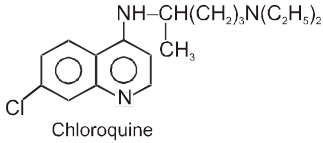- Books Name
- ACME SMART COACHING Chemistry Book
- Publication
- ACME SMART PUBLICATION
- Course
- CBSE Class 12
- Subject
- Chemistry
Drugs According to their Action :
(1) Antacids :
*The chemicals which are used to reduce the acidity of the stomach are called antacids.
*Antacids are nature is basic. Their PH value is in the range of 7.0 to 8.0.
eg. : Omeprazole, Lansoprazole
(2) Antihistamines or Antiallergic Drugs :
*Antihistamines are the drugs which diminish or abolish the effects of histamine.
eg. : Histamine, Cimetidine, Ranitidine
Allergy :
Allergy may be defined as the hypersensitive reponse of the body of certain persons to the external stimulus (such as some drugs, foods, dust, pollen grains, catfur, fabrics etc.)
*The substances which cause allergy are called allergens.
*Most commonly used anti-histamine under the trade name avil :
(3) neurologically Active Drugs
(a) Tranquilizers :
*The chemicals which are used to reduce mental tension, relieve anxiety and mental stress are called Tranquilizer. They act on central nervous system and are hypnotics.
*Tranquilizers are effective in such mental disorder when ordinary hypnotics or sedatives fail. These are called as psychotherapeutic drugs.
eg. : Barbituric acid, Luminal, Serotonin, Bithional
Note : * Reserpine, an alkanoid, is a powerful tranquillzer. It is obtained from a plant, Rauwolfia serpentina (common name - Sarpagandha) which grows in india.
(b) Analgesics : The chemicals which are used for relieving pain are called ANALGESICS.
(i) Non-narcotic analgesics (Non addictive) : Aspirin and Paracetamol belong to this class.
*These drugs also act as antipyretic (reducing fever), and preventing platelet coagulation.
(ii) Narcotic Analgesics :
*Morphine and its homolgues in medicinal doses, relieve pain and produce sleep. In higher doses these produce STUPOR , COMA, CONVULSIONS and ultimately death.
*The narcotics are mainly used for the relief of postoperative pain, cardiac pain and pain of terminal cancer, and in child birth.
eg. : 2-Acetoxy benzoic acid (Aspirin), Paracetamol (4-acidamido phenol), Ibuprofen
(4) Antimicrobials :
*The chemicals which stop the growth or kill the micro organism such as bacteria, virus, fungi, moulds etc are called antimicrobials.
* Antibiotics, antiseptics and disinfectants are antimicrobial drugs.
(a) Antibiotics : *The chemicals produced by micro organisms like bacteria, fungi and moulds that inhibit the growth or destory other micro organism causing infectious diseases in men or animal’s body are called antibiotics. *Alexander fleming in 1929 first.

(I) Penicillin : *Six types of penicillines have been isolated so far. Among them penicillin-G is most widely used and is narrow spectrum.
*Ampicillin and amoxicilline are synthetic modification of penicilline and these has broad spectrum effect.
Penicillin is used for the treatment of pneumonia bronchitis bounds etc.
(II) Streptomycin : It is an effective broad spectrum antibioctic. It is used for the treatment of tuberculosis, meningitis and pneumonia
(III) Tetracyclins : Teramycin and oriomycin are important examples of this class of antibiotics. Teramycin is used for the treatment of typhoid and oriomycin is used for the the treatment of eyes.
(IV) Chloramphenicol : It is marketed as chloromycetin and is used for the treatement of typhoid, dysentery pneumonia, meningitis etc.
(b) Antiseptic and Disinfectants :
*Antiseptics are applied to the living tissues such as wounds, cuts ulcers and diseased skin surface. Examples are furacin, soframycin etc.
*Commonly used antiseptic is detol, it is a mixture of chloroxylenol and terpineol.
*Bithional is added to soaps to impart antiseptic properties.
*Iodoform is also used as antiseptic for wounds, boric acid in dilute aqueous solution is weak antiseptic for eyes.
Disinfactants are the substances which applied to inanimate objects such as floors drainage system instruments etc.
*One substance can act as an antiseptic and also act as disinfactant for example
(a) 0.2 percent solution of phenol is an antiseptic while its 1% solution is disinfectant.
(b) Chlorine in 0.2 to 0.4 ppm in aqueous solution is used to disinfect drinking water.
(c) Hexachlorophen :- It is mainly used in soaps creams and emulsions.
(d) Thymol : It is a natural derivative of phenol and is a powerfull disinfectant
(e) Amyl meta cresol (5-methyl-2-pentyl phenol) it is used as antiseptic in mouth wash or gargles.
(f) Gention violet and methylene blue are organic dyes but used as effective antiseptic.
(c) Sulpha Drugs :
A group of drugs which are derivatives of sulphanilamide are known as sulpha drugs.
eg. : Sulphadiazine, Sulphapyridine
(d) Antimalarials :
*These are the medicines of malaria. In earlier days malaria was treated with the bark of cinchona tree.
* The chloroquine phosphates are sold in the market under the trade name - resochin, ciplaquine, nivaquine etc.

(e) Antifungal Drugs :
*These are drugs used for superfical and deep (systemic) fungal infections.
*Two important antibiotics used as antifungal drugs, introduced way back in 1960, are amphotericin-B and griseofulvin.
(f) Antiamoebic Drugs :
*These are drugs useful in infection, caused by the protozoa Entamoeba histolytica.
*Metronidazole, tinidazole and tetracyclines are important antiamoebic drugs, used these days.
(g) Antiviral Drugs :
* Viruses are the ultimate expression of parasitism; they not only take nutrition from the host cell but also direct its metabolic machinery to synthesize new virus particles.
* Acyclovir, ribavirin, zidovudine, interferons are some of the important antiviral drugs, used these days.
(5) Antifertility Drugs :
“Chemcial substances which are used to check pregnancy in women are called anti-fertility drugs or birth control pills or oral contraceptives”.
*Birth control pills essentially contain a mixture of synthetic estrogen and progesteron derivatives. Both of these compounds are hormones.
eg. : Norethyndron, Ethynylestradiol (novestrol)
*Mifepristone is a synthetic steriod that blocks the effects of progesterone and is used as a “morning after pill” in many countries.
eg. : Mifepriston

 ACME SMART PUBLICATION
ACME SMART PUBLICATION
